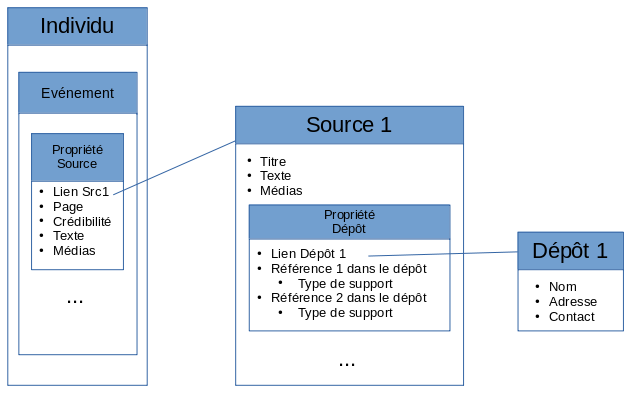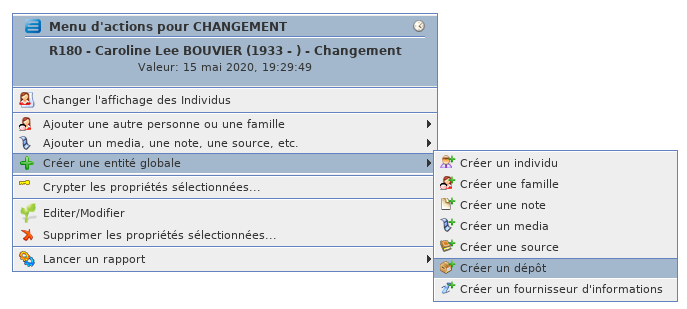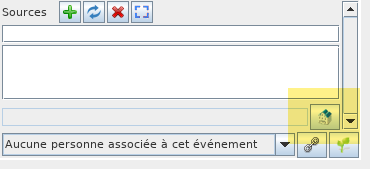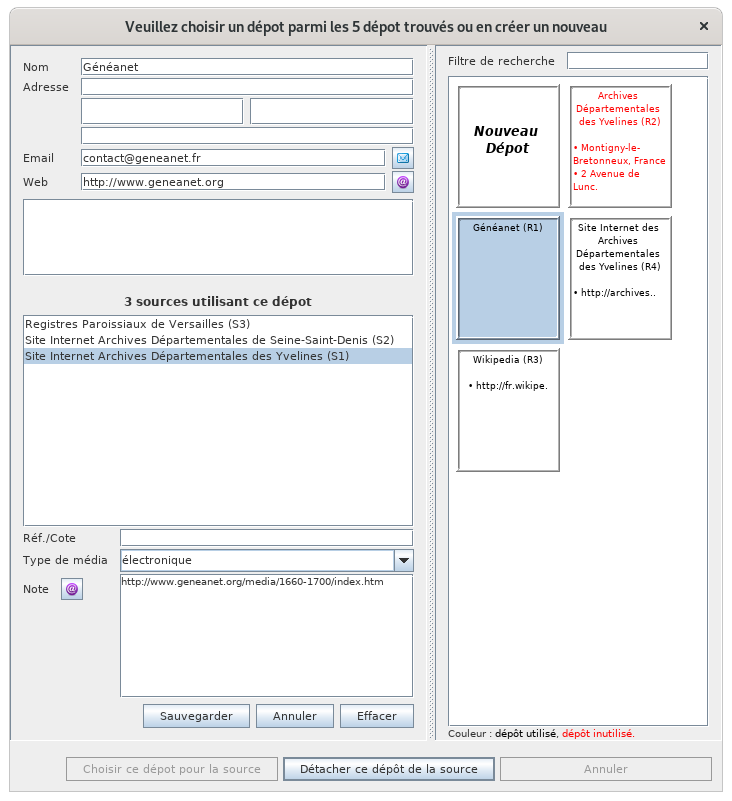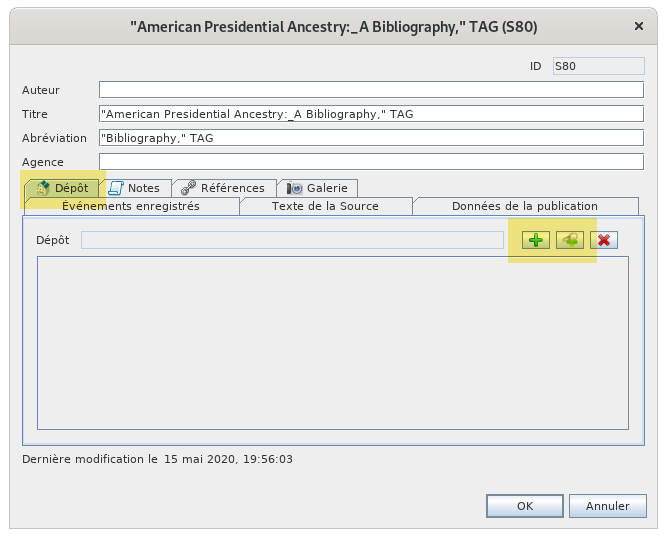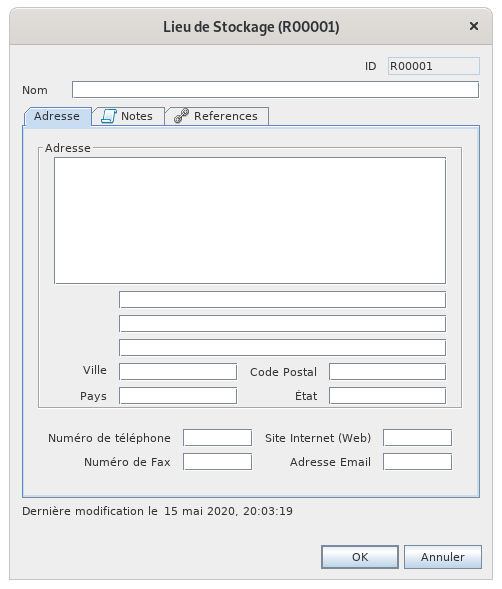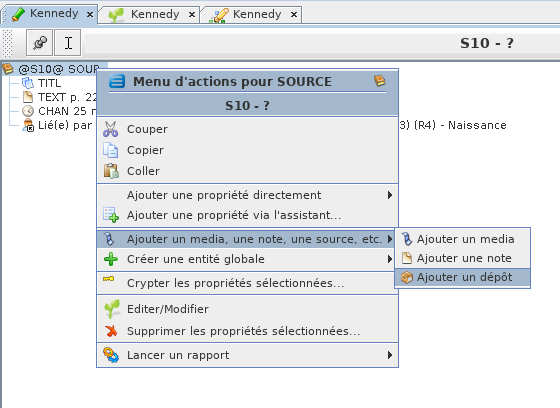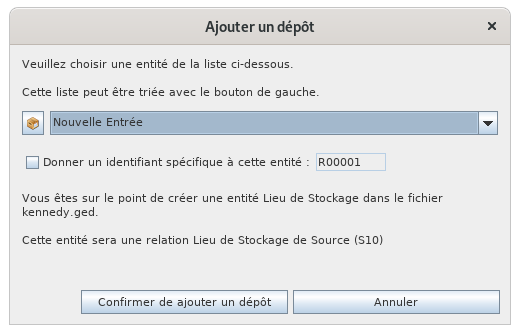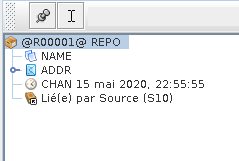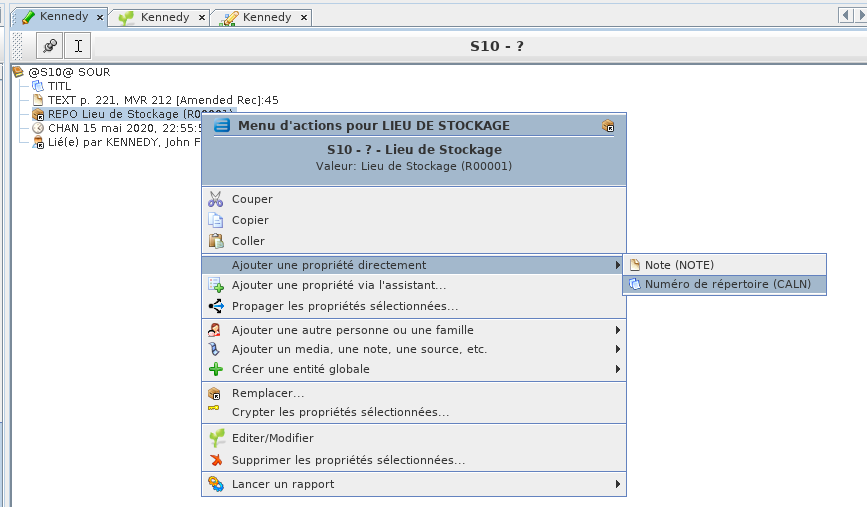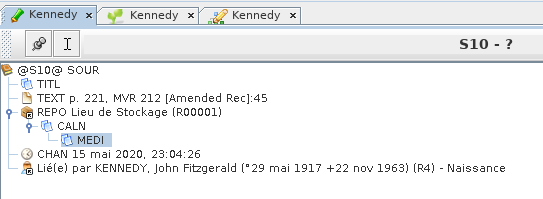Document your sources (STLM)
You will collect many official documents (acts, deeds) that you will need to enter in Ancestris.
Each record you find will enrich your genealogy with individuals, events, sources or notes.
This page will help you know how to enter a deed using sources and repositories.
Importance of documenting your sources
Whatever the origin, every good genealogist must display his/her sources: there is no good genealogy without sources.
The information that constitutes sources for a genealogy can be the result of
- personal research (civil status, notaries, cemeteries, various archives, etc.)
- sharing with other genealogists
- oral information collection
- family document study
Even if the source you have is not the best or is not definitive, you necessarily base the existence of a person or a fact on a source of information. This will be your source and you will keep track of where your information came from, even if it means finding a better source later.
Sources et Repositories
A source is therefore an original transcription on a medium which makes it possible to justify information entered in a genealogy. For example, a parish register, a decennial table, an act of civil status, an act of a parish register, a family book, a tombstone, a video, an audio file.
In addition, any source must be associated to a deposit.
A repository is the place of physical or electronic storage, the geographical site, containing the said original medium (town hall, departmental archives, cemetery, personal address, etc.) or the website (of the county archives of a given region).
How to organize the information in Ancestris
A source is contained in a repository
In Ancestris and in the Gedcom standard, Source entities are contained in Repository entities.
It is when filling in the source that the repository is filled in, which must therefore exist at that time. Therefore, it makes more sense to create the repository before creating the source.
However, this reference to the repository is optional. We can therefore create the source and the repository at the time we need it during the creation of the source, or later.
The editors in Ancestris allow you to enter the entities in the order you want. In practice, in your research and in your data entry procedures, it is more common to enter the containers before the contents, especially since the same repository will be used by several sources.
Where to store the deed and the register?
If the creation of the individual is pretty straight forward, that is via the creation of the entity 'Individual', a choice exists for both the source and the Repository.
Here are indeed the available possibilities where we can write things in the Gedcom standard and therefore in Ancestris.
- Inside a source property, inside a given event of a given individual or family: it will therefore become a non-sharable piece of data. It cannot be referenced by another event. There can be several such properties for the same given event. Each property will include the following information.
- Link to a source entity. This link will have the possible following attributes :
- The page inside the source - Tag:
PAGE - The source quality, on a scale from 0 to 3 - Tag:
QUAY- 0 = Unreliable or data resulting from an estimate
- 1 = Subjective (interviews, oral statement, possible bias, autobiography)
- 2 = Second-hand source, official data reported after the event
- 3 = Direct, official and instant source of the event
- The transcription of the text of the source - Tag:
DATAand subtag:TEXT - Links to multimedia files - Tag:
OBJE - The type of event cited in the source (may be different from the event of the individual to which it is attached) - Tag:
EVEN
- The page inside the source - Tag:
- Link to a source entity. This link will have the possible following attributes :
- Inside a Source entity : it will be a shareable piece of data. It may contain the following information.
- The source title, as a long and a short description - Tags:
TITLandABBRrespectively. - The transcription of the text of the source - Tag:
TEXT - Links to the multimédia files - Tag:
OBJE - Links to the repositories where the source can be found - Tag:
REPO- For each repository, references in the repository, and its index (there could be several of them) - Tag:
CALN- And for erach reference, the type of media support of the source (audio, book, card, electronic, record, film, magazine, manuscript, newspaper, photo, grave, video) - Tag:
MEDI
- And for erach reference, the type of media support of the source (audio, book, card, electronic, record, film, magazine, manuscript, newspaper, photo, grave, video) - Tag:
- For each repository, references in the repository, and its index (there could be several of them) - Tag:
- The event types indicated by the source, with their location and time period - Tag:
DATA/EVEN/DATEandDATA/EVEN/PLAC - The Risponsible Agent - Tag:
DATA/AGNC - The Author who created the source - Tag:
AUTH - The Publication information (when and where) - Tag:
PUBL
- The source title, as a long and a short description - Tags:
- Inside the repository entity : it will be a shareable piece of information. It may contain the followinf information.
- The reposotory Name - Tag:
NAME - The physical address of the repository - Tag:
ADDR - The Internet address - Tag:
WWW - A contact number (phone, email, fax) - Tag:
PHON,EMAIL,FAX.
- The reposotory Name - Tag:
We recommend a principle of efficiency which is to store information in a shareable place if it can be used for several events, or in non-shareable place if it ever be used for a single event, that is to say for a unique individual , or a unique family. See the shared information page for more details.
For the source, this is all the more relevant as it includes a text that is often long to transcribe. It is out of question to enter it several times. We note that this text could be stored in two different places, hence a choice to be made.
So now, a first question: where do we put a marriage certificate and the text of its transcription?
The principle of efficiency tells us that it is safer to enter a marriage certificate in a source entity rather than in a source property.
A marriage certificate could constitute a source of information about several events. That of the marriage of the spouses of course, but it also often informs us about the existence of other individuals, potentially on their name, date and place of birth. The absence of a parent of one of the spouses can also give us some clues about their likely death date.
It is therefore beneficial to enter a marriage certificate in a shared source, therefore in a Source entity.
And the next question is: but then, where do you enter the register which contains the certificate?
According to the Gedcom standard, the registry is rather entered in a source, and the marriage certificate is a page of the registry, which naturally fits into a source property. But then our principle of shared information no longer works.
In addition, the Gedcom standard could suggest to define a cemetery as a repository, and a grave as a source entity. If a cemetery is a repository, why shouldn't a register be a repository? Not easy therefore because in real life, the sources of information are not just arranged on 2 shared levels of information.
Possible choices
Here are possible solutions observed in practice for the example above. There may be others.
| Nb | Individual | Source | Repository | ||||
| Source property |
|||||||
| Event |
Page/ Quality |
Text/Media | Title | Text/Media | Ref repository / Media support | ||
| 1 | Marriage | -/3 | - | Marriage certificate |
Text + Media |
Section 3AB12- Baptism Marriage Burial Register of 1787-nb12 p219/ Manuscript |
National Archives of Boston |
| 2 | Marriage | p.219/3 |
Text + Media |
Baptism Marriage Burial Register of 1787 | - |
Section 3AB12/ Manuscript |
National Archives of Boston |
About choice nb 1 above
- The useful information of the source property is the quality
- This information can only be in the event because it indicates the quality of the source to justify the event, not the quality of the source as such.
- The indication of page numbers or act numbers will rather be included in the reference to the register rather than in the page on the event side, or in the title of the source
- Indeed, if you indicate several repositories for a source (which would then obviously be in different form and with the same content), the act or page number no longer makes sense for several repository referenced at the same time.
About choice nb 2 above
- When the register is a source, the text and the media clearly go to the event side
- The page number makes sense for the event
- The only place to enter the title of the deed is in the text of the source
How to decide? By looking at how many events you will have on average to attach to the same act, and how many acts you will have in the same register.
The closer the ratio is to 1, the more things will have to be stored in the same place, and the larger the ratio, the more they will have to be separated.
- if you think you have a lot of events for the same act, you have to separate the act from the event, otherwise you will spend your time re-entering the same act many times.
- if you think you have a lot of acts in the same register, the more it will be necessary to separate the register of acts. It might also be interesting in this case to merge the register with the repository, but it all depends on whether you have a lot of registers for the same repository.
Our recommendation is to favor information shared at the level of acts, therefore choice 1. This is what the Cygnus editor does. The other two editors allow you to make the choices you want.
As you generalize, you may find it useful to make this type of summary table for all the kinds of sources and repositories you come across.
AssociationAssociating d'unea source àwith una dépôtrepository
CommeAs onwe l'said above, we can create a dit plus haut, on peut créer un source puisand unthen dépôt,a dansrepository, ceor sens,the ouother bienway dans l'autre.around.
LaThe créationcreation desof entitésentities n'estis pasnot documentéedocumented ici.here. CelaThis peutcan sebe fairedone depuisfrom lesthe 3 éditeurs,editors, depuisfrom lethe contextual menu contextueland etfrom depuisthe laAries barreedit d'édition d'Aries.bar.
ExempleExample pourfor lathe créationcreation d'unof dépôta avecrepository lewith the contextual menu contextuelfrom depuisany n'importeentity.
CréationCreation d'unof dépôta depuisrepository lafrom barrethe debutton bouton.bar.
LeThe plusmost important c'estpart l'is the association entrebetween lesthe deux.two.
PlusieursSeveral solutions existentexist selondepending l'éditeuron utilisé.the editor used.
DepuisUsing l'éditeurthe Cygnus editor
DepuisWith Cygnus, lorsquewhen vousyou êtesare trainediting d'éditer unea source, cliquezclick suron lethe boutonRepository Dépôtbutton enat basthe àbottom droite.right.
UnClicking clicon surthis cebutton boutonopens ouvrethe lawindow fenêtrefor dechoosing choixa d'unrepository, dépôt,existing existantor outo àbe créer.created.
DansIn cettethis fenêtre,window, lethe contenudetailed ducontent dépôtof sélectionnéthe àrepository droite,selected n'eston quethe laright partiehand enside, hautis àshowing gauche.at the top of the left hand side.
LaThe listepart duin milieuthe estmiddle lais listethe deslist of used sources quireferenced utilisentby lethis dépôt.repository.
LesThe donnéesdata duat basthe sontbottom lesdisplays références,the dansreferences, lein dépôt,the derepository, laof the source enbeing trainedited, d'êtrethat éditée,is c'est-à-direto cellesay d'oùthe l'onone afrom cliquéwhich justewe avant.clicked Dansjust cettebefore. éditeurIn onthis needitor peutyou mettrecan qu'uneonly référence.put one reference.
DepuisUsing l'éditeurthe Aries editor
DepuisWith Aries, lorswhen deediting l'édition d'unea source, soiteither directementdirectly depuisfrom une entité source, soit depuis laa source d'unentity, événement,or choisissezfrom l'ongletthe dépôtsource puisof cliquezan surevent, l'unchoose desthe deuxrepository boutonstab surlignés.then click on one of the two highlighted buttons.
DansIn lethe cascase duof boutonthe Lier,Attach c'estbutton, unea listelist deof dépôtsrepositories quiappears, apparaît,you iljust voushave suffitto d'enchoose choisir un.one.
DansIn lethe cascase d'unof dépôta quirepository n'existethat pasdoes déjà,not laalready fenêtreexist, suivantethe apparaît.following window appears.
This
Once lesthe donnéesrepository dudata dépôthas saisies,been vousentered, vousyou retrouvezwill surreturn lato fenêtrethe précédenteprevious etwindow vouswhere pouvezyou alorscan indiquerthen lesindicate côtesthe etindex lesand the type deof Media.
DepuisUsing l'éditeurthe Gedcom editor
DepuisFrom l'éditeurthe Gedcom,Gedcom placez-vouseditor, surgo l'entitéto Source,the puisSource faitesentity, unthen clicright droitclick n'importeanywhere oùon surthe letop paneaupanel duof hautthe deGedcom l'éditeureditor, Gedcom,and etchoose choisissezAdd Ajoutez una media, unea note, unea source, etc. puisthen AjouterAdd una dépôt.repository.
LaThe fenêtrefollowing suivantewindow apparaît,appears, soiteither pourto créercreate una nouveaunew dépôt,repository, soitor pourto enchoose choisirone unfrom dethe la liste.list.
SupposonsAssuming queyou vouschoose choisissiezto decreate créera unnew nouveaurepository, dépôt,you vousthen arrivezsee ensuitethis surwindow, cettewhich fenêtre,shows pourthe yfields renseignerof l'addressea parrepository. exemple.You may want to complete the full address.
SiIf vousyou revenezgo surback l'entitéto précédente,the c'est-à-direprevious l'entitéentity, source,i.e. enthe cliquantsource surentity, laby flècheclicking gaucheon dethe laleft barrearrow dein navigation,the vousnavigation voyezbar, queyou lesee dépôtthat the repository has been added.
The references of the repository are added by right-clicking the REPO line, and choosing "Add a étéproperty ajouté.
Les références du dépôt s'ajoutent en faisant un clic droit dur la ligne REPO, et en choisissant "Ajouter une propriété directement"directly", puisthen CALN.CALN.
PuisThen deagain nouveauby enclicking cliquant suron CALN pourto ajouteradd MEDI.
VousYou obtenezget lethe résultatfollowing suivant.result.
EtThere voilà.you go.
OnYou peutmight remarquerhave aunoticed passagethe lesdifferences différencesof d'efficacitéefficiency etand detransparency transparenceof desthe éditeurs.respective editors.

